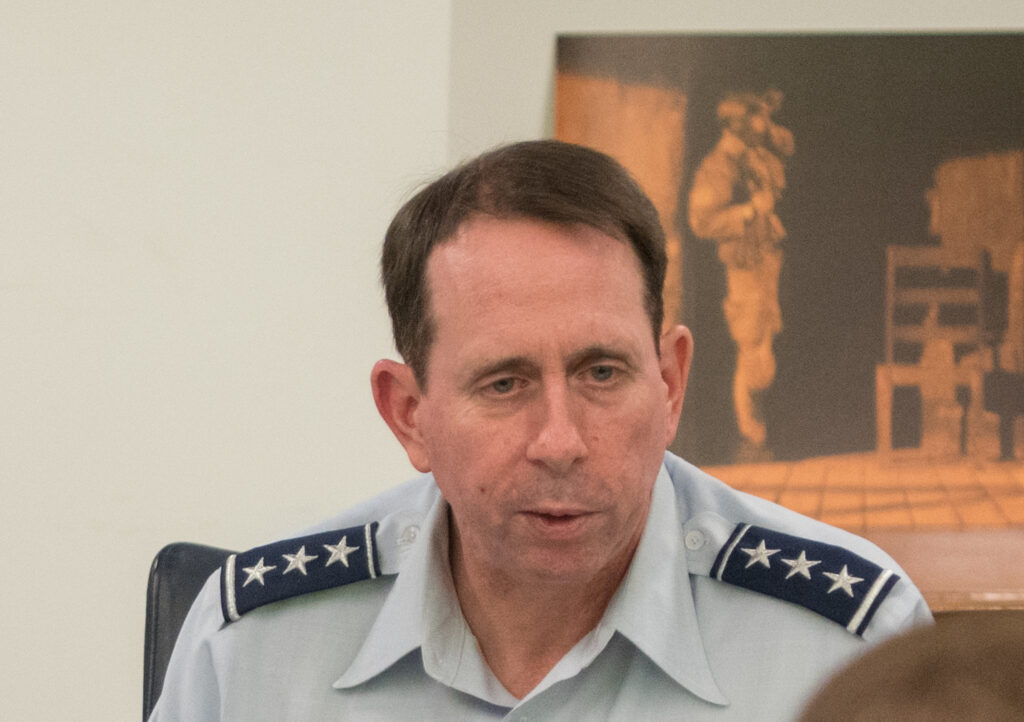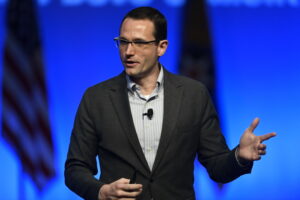
Lt. Gen. Jack Shanahan
WASHINGTON: The legal battle over the JEDI cloud-computing contract has slowed down the Pentagon’s AI program, the director of the Joint Artificial Intelligence Center acknowledges. In the meantime, Lt. Gen. Jack Shanahan told an AFCEA webcast last week, JAIC will turn to a new Air Force program our longtime readers are already familiar with: cloudONE.
Cloud computing matters for AI because machine-learning algorithms need lots of data and lots of processing power. A shared cloud can offer both with far greater efficiencies of scale than any single organization’s in-house network. JEDI was meant to provide a single “general purpose” cloud to all users across the Defense Department, including Shanahan’s Joint AI Center. But it has been mired for months in legal battles over which company should have won the contract, Microsoft Azure or Amazon Web Services.
“It slowed us down, no question about it,” Shanahan told the AFCEA audience.
“Azure, AWS, I will never get into a company discussion. I’m agnostic,” he said. “[But] if we want to make worldwide updates to all these algorithms in the space of minutes, not in the space of months running around gold disks, we’ve got to have an enterprise cloud solution.”
JEDI can’t be that solution today, Shanahan acknowledged, but “we now have a good plan to account for the fact that it will be delayed potentially many more months.”
For instance, as the COVID-19 pandemic spread, the Joint AI Center urgently stood up what they call Project Salus – named for the Roman goddess of health and safety – to pull data from 70 different sources, find patterns, and predict trends for US Northern Command and the National Guard. Salus went from a sketch on a “bar napkin” to a functional bare-bones system (what’s called a Minimum Viable Product) in 29 days, Shanahan said. With JEDI unavailable, he turned to an existing Air Force cloud run out of Hanscom Air Force Base, which he’d previously used as head of Project Maven.
But the Hanscom-based cloud is “an interim solution that will end … here later in the fall,” Shanahan said. “Because of that, we are pivoting to the cloudONE environment.”

Will Roper
CloudONE & Beyond
So what’s cloudONE? Like JEDI, it’s a new cloud-computing capability that the Air Force hopes will be available to a wide range of users from across the Department of Defense. Unlike JEDI, it’s not a joint program run by the Office of the Secretary of Defense, but a service program, run by the Air Force.
In fact, cloudOne is part of a whole package of computing initiatives – deviceONE, dataONE, et al – that the Air Force acquisition chief, Will Roper, began pushing (and branding) aggressively last year. Further, while JEDI is meant as the Defense Department’s “general purpose” cloud, Roper’s many ONEs are all intended to serve a single purpose, albeit a broad one: military command and control.
Together, Roper’s projects will make up what the Air Force is calling its Advanced Battle Management System. ABMS, in turn, will be an Air Force component of the future Joint All-Domain Command and Control (JADC2) meta-network to share battle data between all the armed services across all five “domains” of warfare: land, sea, air, space, and cyberspace.
Artificial intelligence is essential for JADC2, since human analysts can’t pull together that much data from that many sources fast enough to make a difference in combat. The JAIC is far too small to build the whole JADC2 network – that’s up to the far better-resourced services – but it can help.
“We’re not here to build JADC2,” he said. “We’re here to find AI-enabled solutions that stitch seams together from all the services, who’re [each] developing some version of JADC2.”
The objective is to automate and accelerate the often-laborious process of bringing American firepower to bear. That “kill chain” includes everything from spotting a potential target with some kind of sensor, confirming what it is with other sensors, deciding to strike it, picking an aircraft, warship, or artillery battery to execute the strike, and then giving that shooter precise targeting data. Currently most of that requires human beings relaying coordinates and orders over the radio, typing them into terminals by hand, or even scrawling them on sticky notes because one network can’t transfer data to another.
“Accelerated sensor-to-shooter timelines are so important – to me, this is what the next couple of years will be about, and each of the services has a really strong programs in sensor-to-shooter,” Shanahan said. “What we’re trying to bring is the AI/ML solutions.”
To do that job, however, the JAIC needs more people and more legal authorities to conduct acquisitions on its own – although it will never be the size of the services’ acquisition bureaucracies.
For example, while Shanahan initially focused on lower-risk, non-combat applications of AI like maintenance, on May 18 the JAIC awarded Booz Allen Hamilton a landmark contract worth up to $800 million for AI “to support warfighting operations [and] decision-making and analysis at all tiers of DoD operations.” But JAIC did so in partnership with the civilian General Services Administration (using GSA’s Alliant 2 contract vehicle), just as it’s done past contracts through the Defense Information Systems Agency and other established organizations, because it doesn’t have the necessary authorities and personnel in-house – yet.
“I couldn’t ask for better support,” Shanahan said, “but it’s not going to be fast enough as we start putting more and more money into this capability development. We need our own acquisition authority.” In particular, he sees JAIC as a potential early adopter of the new streamlined process for software development and acquisition recently rolled out by the Pentagon’s acquisition chief, Ellen Lord.
The JAIC also needs to get bigger. Founded in summer 2018 with just four staff, JAIC has now grown to 175 personnel (counting contractors) and must keep growing, Shanahan said. But that larger staff won’t include Shanahan: JAIC’s founding director retires from the Air Force next month.
Air Force awards SNC $13B contract for new ‘Doomsday’ plane
The win is a major victory for the firm in a competition that saw the surprise elimination of aerospace giant Boeing.


























